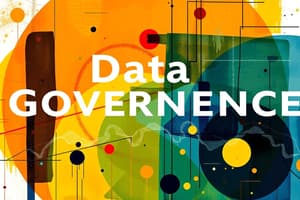Podcast
Questions and Answers
Which of the following scenarios best illustrates the application of 'Goal Seek' in a spreadsheet program?
Which of the following scenarios best illustrates the application of 'Goal Seek' in a spreadsheet program?
- Creating multiple scenarios with varying interest rates to analyze their effect on a loan payment schedule.
- Optimizing a delivery route by considering multiple destinations and minimizing travel time.
- Determining the overall profit margin by adjusting various expense categories within a fixed budget.
- Finding the required sales volume to achieve a specific revenue target, given a set selling price. (correct)
In the context of data management, which of the following strategies primarily focuses on maintaining data accuracy and completeness?
In the context of data management, which of the following strategies primarily focuses on maintaining data accuracy and completeness?
- Data security protocols
- Data governance
- Data quality management (correct)
- Data storage optimization
A network administrator needs to implement a solution that directs network traffic between different networks. Which of the following network hardware devices is most suited for this task?
A network administrator needs to implement a solution that directs network traffic between different networks. Which of the following network hardware devices is most suited for this task?
- Router (correct)
- Firewall
- Switch
- Hub
When designing a relational database, which of the following steps is crucial for minimizing data redundancy and improving data integrity?
When designing a relational database, which of the following steps is crucial for minimizing data redundancy and improving data integrity?
Which SQL command is used to retrieve specific columns from a database table, while also applying conditions to filter the results??
Which SQL command is used to retrieve specific columns from a database table, while also applying conditions to filter the results??
In spreadsheet software, which feature would be most helpful for displaying only customers who made purchases above a certain dollar amount?
In spreadsheet software, which feature would be most helpful for displaying only customers who made purchases above a certain dollar amount?
Which HTML tag is used to create a hyperlink that directs users to another website?
Which HTML tag is used to create a hyperlink that directs users to another website?
When using the 'Solver' tool in a spreadsheet program, what is the primary purpose of defining 'constraints'?
When using the 'Solver' tool in a spreadsheet program, what is the primary purpose of defining 'constraints'?
A database table contains customer information, including names, addresses, and phone numbers. Which SQL command would you use to modify a customer's address?
A database table contains customer information, including names, addresses, and phone numbers. Which SQL command would you use to modify a customer's address?
Which of the following best describes the function of a 'foreign key' in a relational database?
Which of the following best describes the function of a 'foreign key' in a relational database?
Flashcards
Data Management
Data Management
Managing data securely, efficiently, and cost-effectively.
Data Quality Management
Data Quality Management
Ensuring data is accurate, complete, and consistent.
Networking
Networking
Connecting devices to share resources.
Routers
Routers
Signup and view all the flashcards
Switches
Switches
Signup and view all the flashcards
Database
Database
Signup and view all the flashcards
Primary Key
Primary Key
Signup and view all the flashcards
Foreign Key
Foreign Key
Signup and view all the flashcards
Goal Seek
Goal Seek
Signup and view all the flashcards
Solver
Solver
Signup and view all the flashcards
Study Notes
- Information Technology (IT) encompasses the use of computers, storage, networking, and other physical devices, infrastructure, and processes to create, process, store, secure, and exchange all forms of electronic data.
- IT is used in various contexts, including business, healthcare, education, and government.
- Its role is to make data accurate, reliable, and available to users.
Data Management
- Data management involves the practices of collecting, keeping, and using data securely, efficiently, and cost-effectively.
- It helps organizations make informed decisions, improve operations, and reduce risks.
- Key processes include data governance, data quality management, data storage, and data security.
- Data governance establishes policies and procedures for data management.
- Data quality management ensures data accuracy, completeness, and consistency.
- Data storage involves choosing appropriate storage solutions (e.g., cloud, on-premises).
- Data security protects data from unauthorized access and breaches.
Networking
- Networking refers to connecting devices (like computers, servers, and mobile devices) to share resources.
- Computer networks can be local (LANs) or wide area (WANs), like the internet.
- Networking relies on protocols such as TCP/IP to standardize communication.
- Network devices include routers, switches, and firewalls.
- Routers direct traffic between networks.
- Switches connect devices within a single network.
- Firewalls protect networks from unauthorized access.
- Wireless networking technologies include Wi-Fi and Bluetooth.
Databases
- A database is a structured collection of data that is organized for easy access and management.
- Database Management Systems (DBMS) like MySQL, Oracle, and SQL Server are used to create, manage, and access databases.
- Relational databases organize data into tables with rows and columns.
- Key database concepts include tables, records, fields, and keys.
- Tables store data in a structured format.
- Records (rows) represent individual entities or items.
- Fields (columns) represent attributes of the entities.
- Keys are used to identify records uniquely and establish relationships between tables (primary key, foreign key).
- Database normalization reduces redundancy and improves data integrity.
- SQL (Structured Query Language) is used to interact with databases, including querying, inserting, updating, and deleting data.
Hyperlink
- A hyperlink is an element in an electronic document that links to another place in the same document or to an entirely different document.
- Hyperlinks are commonly used on websites to navigate between pages.
- They can link to text, images, or other media.
- HTML uses the
<a>tag to create hyperlinks. - Hyperlinks enhance user experience by providing easy access to related information.
Goal Seek
- Goal Seek is a feature available in spreadsheet programs like Microsoft Excel that allows you to calculate the input value needed to achieve a desired output (goal).
- It is useful for "what-if" analysis, particularly when you know the desired result but not the input required to achieve it.
- Goal Seek changes only one input value to reach the specified goal.
- It is an iterative process that finds the input value through trial and error.
- Goal Seek is typically found under the "Data" tab in Excel, within the "What-If Analysis" tools.
Solver
- Solver is a more advanced "what-if" analysis tool in spreadsheet programs like Excel that optimizes a solution by adjusting multiple input variables subject to constraints.
- It can be used to solve complex optimization problems, such as resource allocation, scheduling, and financial modeling.
- Solver requires defining an objective function (the value to be maximized or minimized), decision variables (the inputs to be adjusted), and constraints (limitations on the variables).
- Solver uses algorithms to find the optimal solution that satisfies the constraints and achieves the best possible value for the objective function.
- Solver is typically implemented as an add-in.
Sorting
- Sorting is the process of arranging data in a specific order, either ascending or descending.
- Sorting can be applied to text, numbers, and dates in spreadsheet programs or databases.
- In spreadsheets, sorting allows you to quickly organize and analyze data by arranging rows based on the values in one or more columns.
- Sorting algorithms include bubble sort, quicksort, and merge sort.
- Simple sorting can be achieved directly from the ribbon toolbar in most spreadsheet programs.
Filtering
- Filtering is the process of displaying only the records that meet specific criteria while hiding the rest.
- Data filtering can be applied to columns in a spreadsheet or tables in a database.
- Filters allow you to focus on relevant subsets of data and analyze them more effectively.
- Common filter criteria include specific values, ranges, or patterns.
- Advanced filtering options allow you to combine multiple criteria using logical operators (AND, OR).
SQL Commands
- SQL (Structured Query Language) commands are used to interact with relational databases.
- Key SQL commands include:
SELECT: Retrieves data from one or more tables.INSERT: Adds new data into a table.UPDATE: Modifies existing data in a table.DELETE: Removes data from a table.CREATE: Creates database objects such as tables, views, and indexes.ALTER: Modifies the structure of existing database objects.DROP: Deletes database objects.JOIN: Combines rows from two or more tables based on a related column.WHERE: Filters records based on a specified condition.GROUP BY: Groups rows with the same values in one or more columns.ORDER BY: Sorts the result set based on one or more columns.
- The basic structure of a SQL query involves specifying the action, the target table, and any conditions or criteria.
Studying That Suits You
Use AI to generate personalized quizzes and flashcards to suit your learning preferences.




